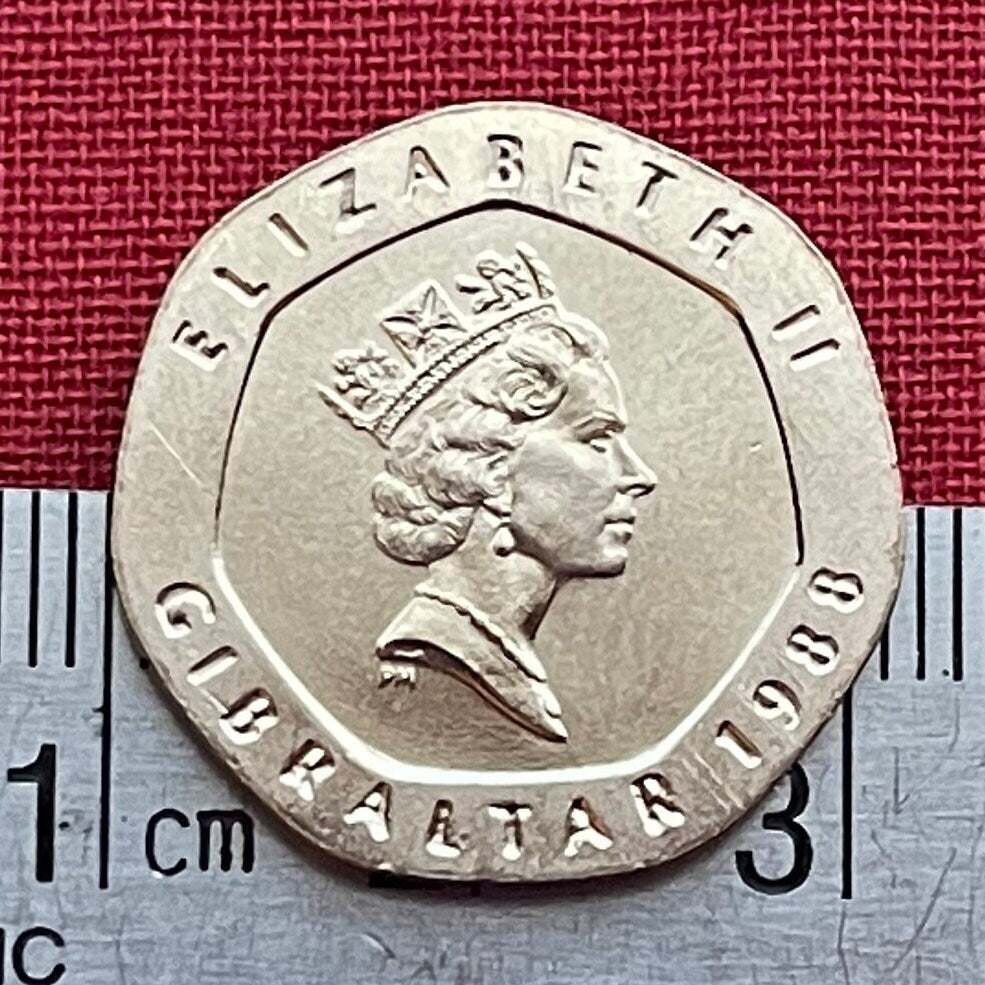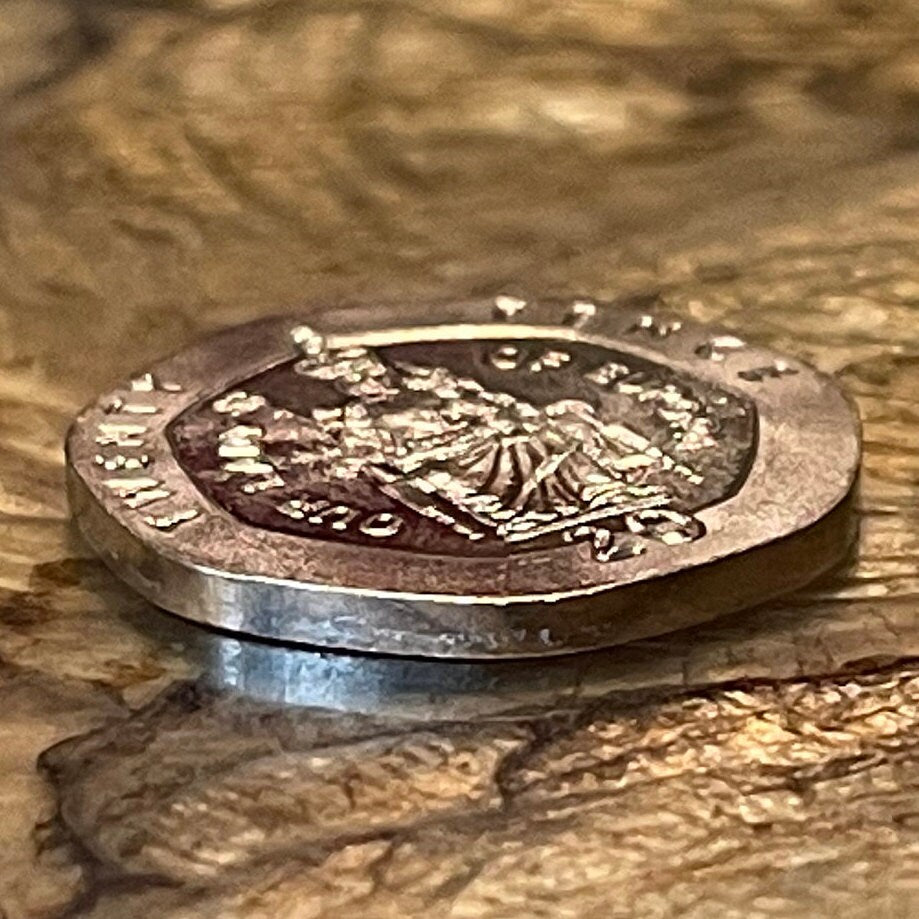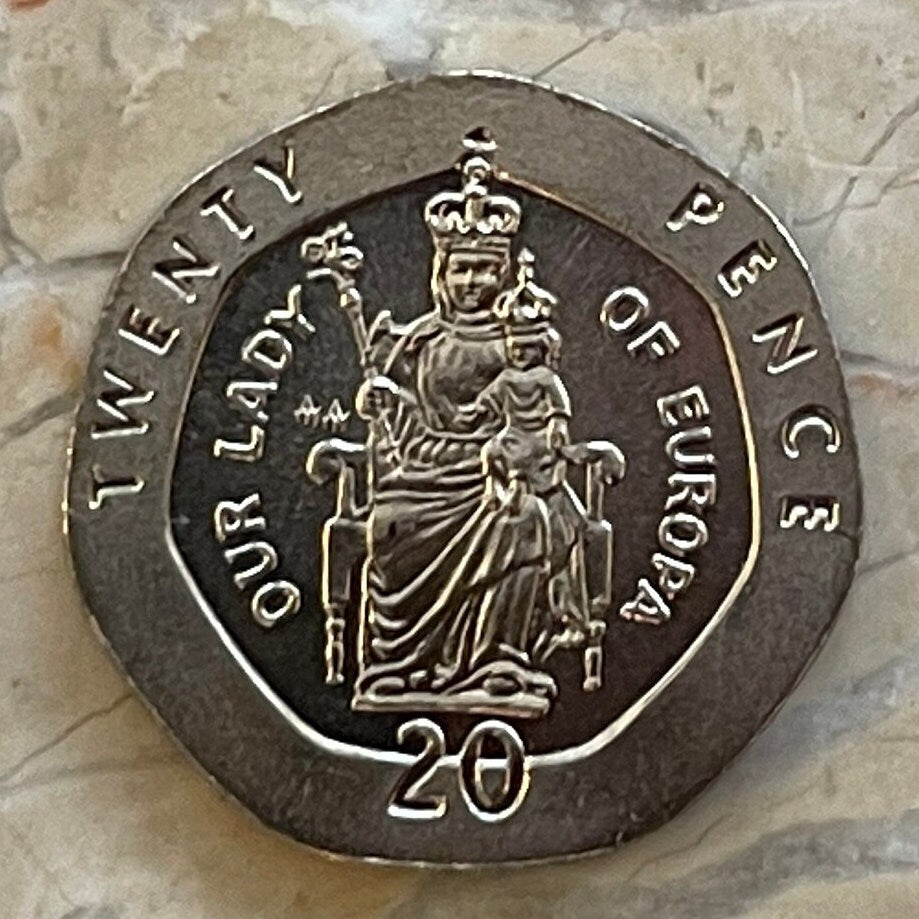elemintalshop
Our Lady of Europa with Crowned Christ Child 20 Pence Gibraltar Authentic Coin Money for Jewelry (Virgin Mary) (Heptagonal Coin) (Easter)
Our Lady of Europa with Crowned Christ Child 20 Pence Gibraltar Authentic Coin Money for Jewelry (Virgin Mary) (Heptagonal Coin) (Easter)
Couldn't load pickup availability
Our Lady of Europa 20 Pence Gibraltar Authentic Coin Money for Jewelry and Crafts Making (Virgin Mary) (Miracles) (Heptagonal Coin)
Commemorative issue: Our Lady of Europa
Obverse: Crowned head right
Lettering: ELIZABETH II
GIBRALTAR
Reverse: 16th century polychrome wood statue, 2 feet tall, called Our Lady of Europa
Lettering: TWENTY PENCE
OUR LADY OF EUROPA
20
Features
Issuer Gibraltar
Queen Elizabeth II (1952-date)
Type Circulating commemorative coin
Years 1988-1997
Value 20 Pence
0.2 GIP = USD 0.25
Currency Pound (decimalized, 1971-date)
Composition Copper-nickel
Weight 5 g
Diameter 21.4 mm
Thickness 1.6 mm
Shape Equilateral curve heptagon (7-sided)
Technique Milled
Orientation Medal alignment ↑↑
Number N# 11549
References KM# 16
Wikipedia:
Our Lady of Europe (Spanish: Nuestra Señora de Europa or Virgen de Europa, Latin: Domina Nostra ab Europa) is a title given to the Blessed Virgin Mary patroness of Gibraltar and protectress of Europe. The entire European continent was consecrated under the protection of Our Lady of Europe in the early 14th century from the Shrine in Gibraltar where devotion continues to this day, over 700 years on.
Together with Saint Bernard of Clairvaux, Our Lady is a Catholic patron saint of Gibraltar, and as such protector of the whole of Europe.
Background
The peninsula now known as Gibraltar was at one time called Calpe. Gibraltar takes its name from the phrase Gibel Tarik, which means "the Mountain of Tarik", and commemorates the capture of the peninsula by Tarik Ibn Zayid in 710. Moslem troops built a fortress and a mosque at Europa Point at the southernmost part of Gibraltar, located just across from the North African coast.
Origins during the Spanish period
In 1309, King Ferdinand IV of Castile took Gibraltar, driving the Moslem troops back across the strait to Africa. The King converted the ancient mosque into a Christian Shrine. The Moslems again captured Gibraltar 24 years later in 1333. In 1462 King Henry IV recaptured Gibraltar and restored the devotion to Our Lady of Europe initiated by his grandfather, Ferdinand, once again transforming the ancient mosque into a Christian Shrine.
Ceuta, on the southern shore of the Strait of Gibraltar, had been captured in 1415 by the Portuguese, under King John I. In 1421 the King's son, Henry the Navigator, sent a Holy Virgin's statue to Ceuta in order to consecrate Africa to the Blessed Virgin Mary under the invocation of Our Lady of Africa. That way, each of the two Pillars of Hercules was the site of a Marian shrine, consecrating both continents to Our Lady.
A chapel was later built over the remains of the mosque and the whole area became known as the Shrine of Our Lady of Europe (Spanish: Santuario de Nuestra Señora de Europa). A statue of the Virgin and Child was installed in there in the 15th century. The statue was quite small, only two feet in height, carved in wood and polychromed in royal red, blue and gold. The Virgin was seated in a simple chair, with the Child Jesus on her lap. Both were crowned and the Virgin held in her right hand a sceptre with three flowers denoting Love, Truth and Justice.
On September 10, 1540 Gibraltar suffered a raid by Barbarossa's Barbary corsairs. The Shrine was pillaged and the statue of Our Lady badly mutilated and broken into pieces. It was eventually restored in Seville and brought back to the Shrine.
The shrine prospered in fame and popularity, for well over two centuries. Ships passing through the Strait of Gibraltar saluted Our Lady as they passed Europa Point and mariners often came ashore with offerings for the shrine. Provision was made for a supply of oil to keep a lamp burning in the shrine tower (former minaret), thus making it a navigational beacon. Notable gifts include a silver lamp, given in 1568 by Giovanni Andrea Doria (great-nephew of the great Genoese admiral Andrea Doria), and two massive silver lamps presented by John of Austria, upon his victory at the Battle of Lepanto.
Alonso Hernández del Portillo, a councilor from Gibraltar during late 16th and early 17th century and first chronicler of the city, narrates in his Historia de la Muy Noble y Más Leal Ciudad de Gibraltar (1610–22) (English: History of the Very Noble and Most Loyal City of Gibraltar) the story of many other declared miracles attributed to Our Lady of Europe, one of them having been witnessed by himself. Another historian, Fray Jerónimo de la Concepción, in his work Cadiz Ilustrada (1690), also records many such miracles which occurred in Gibraltar.
One notable miracle was that of fisherman Luis Lecayo in 1633. He was caught in a heavy storm at night, thrown into the turbulent sea, and considered himself lost only praying to Our Lady of Europe for help. He survived and later gave his account of the claimed miracle to the Bishop of Cádiz, Domingo Cano de Haro, who promoted devotion to Our Lady within the Diocese of Cádiz.
A confraternity, the Confraternity of Our Lady of Europe (Spanish: Cofradía de Nuestra Señora de Europa), was later established. A larger statue of Our Lady of Europe was specifically carved and enthroned in the town's central church, the Church of St. Mary the Crowned and St. Bernard (Spanish: Iglesia de Santa Maria la Coronada y San Bernado, presently the Cathedral of the Roman Catholic Diocese of Gibraltar). The confraternity was disestablished some time after 1704.
The Capture of Gibraltar
In 1704, during the War of the Spanish Succession, Anglo-Dutch troops captured Gibraltar. The shrine, as most other Catholic places of worship was desecrated and was taken over for military use. The shrine was looted and the statue of the Virgin and Child was broken and its remains thrown out to sea. As the statue was carved from wood, the pieces were recovered by a fisherman who found them floating in the Bay of Gibraltar and later delivered them to Juan Romero de Figueroa, the priest in charge at the Church of St. Mary the Crowned and St. Bernard, who took the pieces of the statue to Algeciras for safekeeping. They were placed in the Chapel of St. Bernard, which was then dedicated to Our Lady of Europe and named (Spanish: Capilla de Nuestra Señora de Europa).
Share










This is such a fascinating addition.
5 stars review from Shannon









